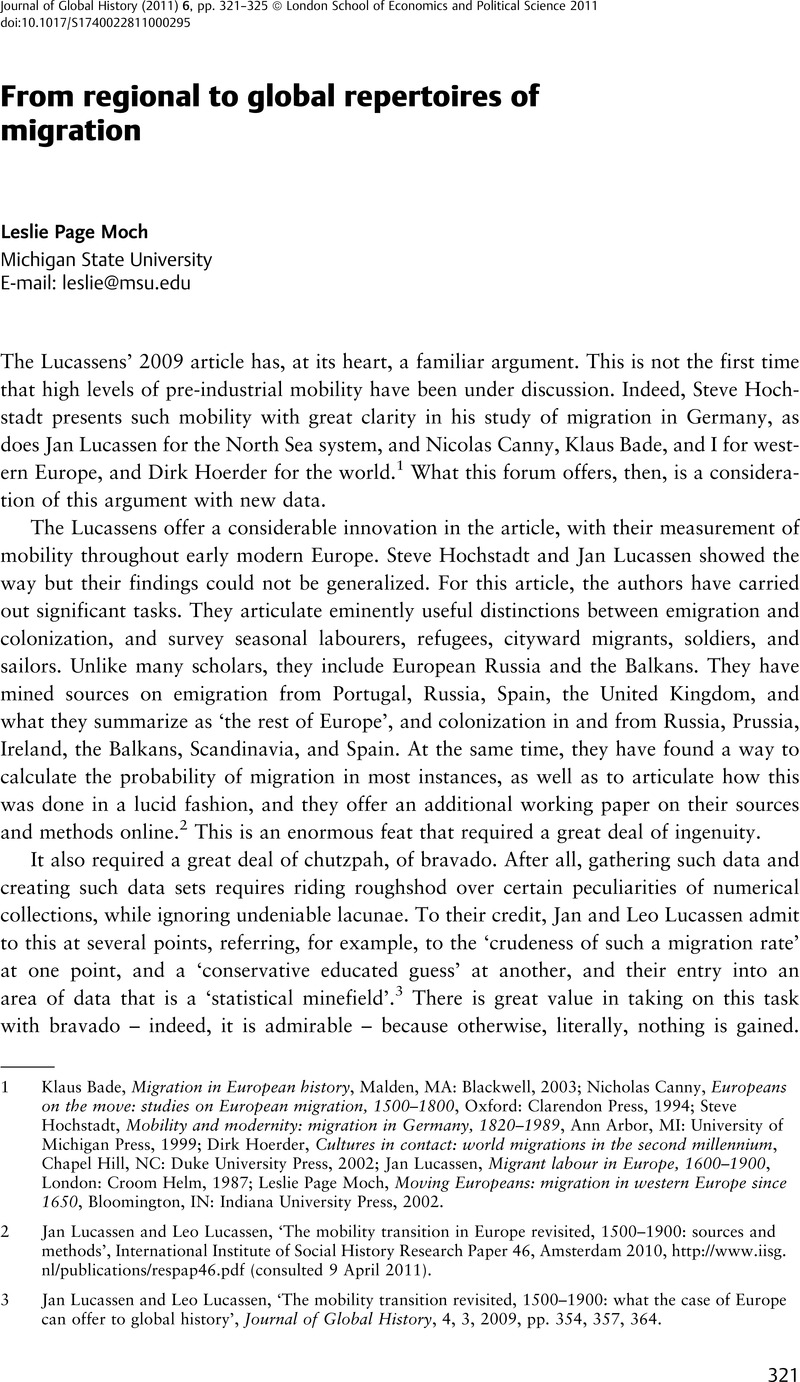Article contents
From regional to global repertoires of migration
Published online by Cambridge University Press: 13 June 2011
Abstract

- Type
- Articles
- Information
- Copyright
- Copyright © Cambridge University Press 2011
References
1 Bade, Klaus, Migration in European history, Malden, MA: Blackwell, 2003CrossRefGoogle Scholar; Canny, Nicholas, Europeans on the move: studies on European migration, 1500–1800, Oxford: Clarendon Press, 1994CrossRefGoogle Scholar; Hochstadt, Steve, Mobility and modernity: migration in Germany, 1820–1989, Ann Arbor, MI: University of Michigan Press, 1999CrossRefGoogle Scholar; Hoerder, Dirk, Cultures in contact: world migrations in the second millennium, Chapel Hill, NC: Duke University Press, 2002CrossRefGoogle Scholar; Lucassen, Jan, Migrant labour in Europe, 1600–1900, London: Croom Helm, 1987Google Scholar; Moch, Leslie Page, Moving Europeans: migration in western Europe since 1650, Bloomington, IN: Indiana University Press, 2002Google Scholar.
2 Jan Lucassen and Leo Lucassen, ‘The mobility transition in Europe revisited, 1500–1900: sources and methods’, International Institute of Social History Research Paper 46, Amsterdam 2010, http://www.iisg.nl/publications/respap46.pdf (consulted 9 April 2011).
3 Jan Lucassen and Leo Lucassen, ‘The mobility transition revisited, 1500–1900: what the case of Europe can offer to global history’, Journal of Global History, 4, 3, 2009, pp. 354, 357, 364.
4 Ibid., p. 351.
5 Boeck, Brian J., ‘Containment vs. colonization: Muscovite approaches to settling in the steppe’, in Breyfogle, Nicholas B. et. al., eds., Peopling the Russian periphery: borderland colonization in Eurasian history, London: Routledge, 2007, 41Google Scholar.
6 Wilbur Zelinsky, ‘The hypothesis of the mobility transition’, Geographical Review, 61, 2, 1971, pp. 219–49.
7 Lucassen and Lucassen, ‘Mobility transition’, p. 371.
8 Jackson, James Jr, Migration and urbanization in the Ruhr valley, 1821–1914, Atlantic Highlands, NJ: Humanities Press, 1997Google Scholar; Hochstadt, Mobility and modernity.
9 Lucassen and Lucassen, ‘Mobility transition’, p. 376. The choice to define soldiers as migrants is debatable first for the reason given at the opening of this article – socially, soldiers do not necessarily leave home – and second because soldiers can be understood (and indeed were categorized by French censuses) as an institutionalized population. Third, the long-term trends in proportion of males aged twenty to fourty-four in the military is affected by a host of state-related factors that may be unrelated to migration; see Tilly, Charles, Coercion, capital, and European states, AD 990–1992, Oxford: Blackwell, 1992, pp. 122–3Google Scholar.
10 Daniel Brower and Susan Layton, ‘Liberation through captivity: Nikolai Shipov’s adventure in the imperial borderlands’, Kritika: Explorations in Russian and Eurasian History, 6, 2, 2005, pp. 259–79; McKay, John, Four Russian serf narratives, Madison, WI: University of Wisconsin Press, 2009, pp. 118–96Google Scholar; Fayzullaeva, Eleonora, ‘Labor migration in Central Asia: gender challenges’, in Racioppi, L. P. and See, K. O., eds., Gender politics in post-communist Eurasia, East Lansing, MI: Michigan State University Press, 2009, pp. 237–65.Google Scholar
11 Gabaccia, Donna, From the other side: women, gender and immigrant life in the U.S., 1820–1910, Bloomington, IN: Indiana University Press, 1994Google Scholar; Adam McKeown, ‘Chinese emigrants in global context, 1850–1910’, Journal of Global History, 5, 1, 2010, pp. 95–124.
12 Most recently, the Gender Ratios Working Group, sponsored by the Russell Sage Foundation, met in June 2009; of interest is Donna Gabaccia and Elizabeth Zanoni, ‘Transitions in gender ratio among international migrants, 1820–1930’, from that meeting, and Trent Alexander and Annemarie Steidl, ‘Gender and the “laws of migration”: a reconsideration of nineteenth-century patterns’, unpublished paper for the annual meeting of the Population Association of America, Dallas, Texas, April 2010. See also United Nations Population Fund, State of world population 2006: unleashing the power of urban growth, New York: United Nations Press, 2006, http://www.unfpa.org/swp/ (consulted 9 April 2011)Google Scholar; Wilcox, W. and Ferenczi, I., eds., International migrations, Publications of the National Bureau of Economic Research 14, New York: Arno Press, 1929, reprinted 1970Google Scholar.
- 1
- Cited by




